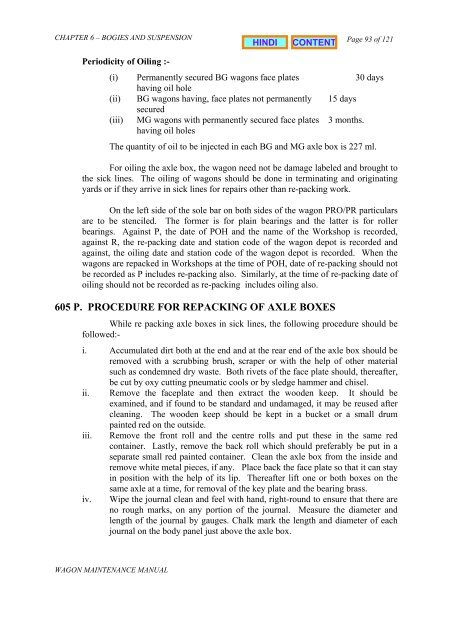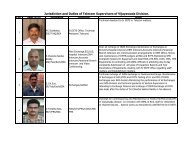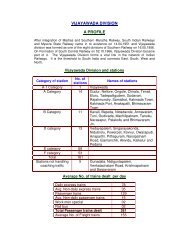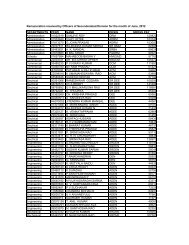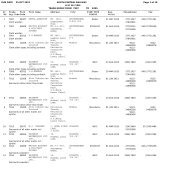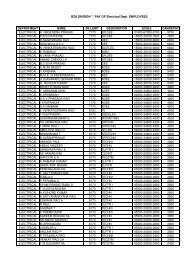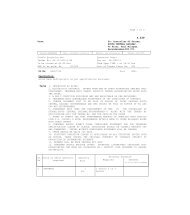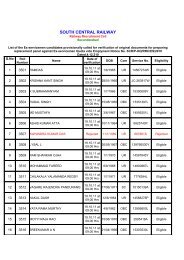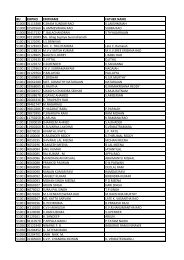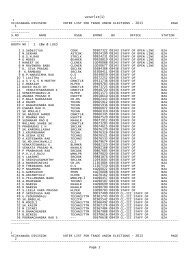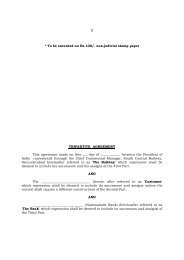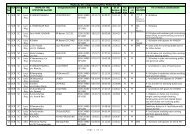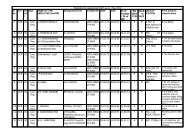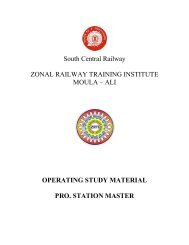BOGIES AND SUSPENSION - South Central Railway
BOGIES AND SUSPENSION - South Central Railway
BOGIES AND SUSPENSION - South Central Railway
Create successful ePaper yourself
Turn your PDF publications into a flip-book with our unique Google optimized e-Paper software.
CHAPTER 6 – <strong>BOGIES</strong> <strong>AND</strong> <strong>SUSPENSION</strong><br />
Periodicity of Oiling :-<br />
WAGON MAINTENANCE MANUAL<br />
Page 93 of 121<br />
(i) Permanently secured BG wagons face plates 30 days<br />
having oil hole<br />
(ii) BG wagons having, face plates not permanently 15 days<br />
secured<br />
(iii) MG wagons with permanently secured face plates 3 months.<br />
having oil holes<br />
The quantity of oil to be injected in each BG and MG axle box is 227 ml.<br />
For oiling the axle box, the wagon need not be damage labeled and brought to<br />
the sick lines. The oiling of wagons should be done in terminating and originating<br />
yards or if they arrive in sick lines for repairs other than re-packing work.<br />
On the left side of the sole bar on both sides of the wagon PRO/PR particulars<br />
are to be stenciled. The former is for plain bearings and the latter is for roller<br />
bearings. Against P, the date of POH and the name of the Workshop is recorded,<br />
against R, the re-packing date and station code of the wagon depot is recorded and<br />
against, the oiling date and station code of the wagon depot is recorded. When the<br />
wagons are repacked in Workshops at the time of POH, date of re-packing should not<br />
be recorded as P includes re-packing also. Similarly, at the time of re-packing date of<br />
oiling should not be recorded as re-packing includes oiling also.<br />
605 P. PROCEDURE FOR REPACKING OF AXLE BOXES<br />
While re packing axle boxes in sick lines, the following procedure should be<br />
followed:-<br />
i. Accumulated dirt both at the end and at the rear end of the axle box should be<br />
removed with a scrubbing brush, scraper or with the help of other material<br />
such as condemned dry waste. Both rivets of the face plate should, thereafter,<br />
be cut by oxy cutting pneumatic cools or by sledge hammer and chisel.<br />
ii. Remove the faceplate and then extract the wooden keep. It should be<br />
examined, and if found to be standard and undamaged, it may be reused after<br />
cleaning. The wooden keep should be kept in a bucket or a small drum<br />
painted red on the outside.<br />
iii. Remove the front roll and the centre rolls and put these in the same red<br />
container. Lastly, remove the back roll which should preferably be put in a<br />
separate small red painted container. Clean the axle box from the inside and<br />
remove white metal pieces, if any. Place back the face plate so that it can stay<br />
in position with the help of its lip. Thereafter lift one or both boxes on the<br />
same axle at a time, for removal of the key plate and the bearing brass.<br />
iv. Wipe the journal clean and feel with hand, right-round to ensure that there are<br />
no rough marks, on any portion of the journal. Measure the diameter and<br />
length of the journal by gauges. Chalk mark the length and diameter of each<br />
journal on the body panel just above the axle box.


